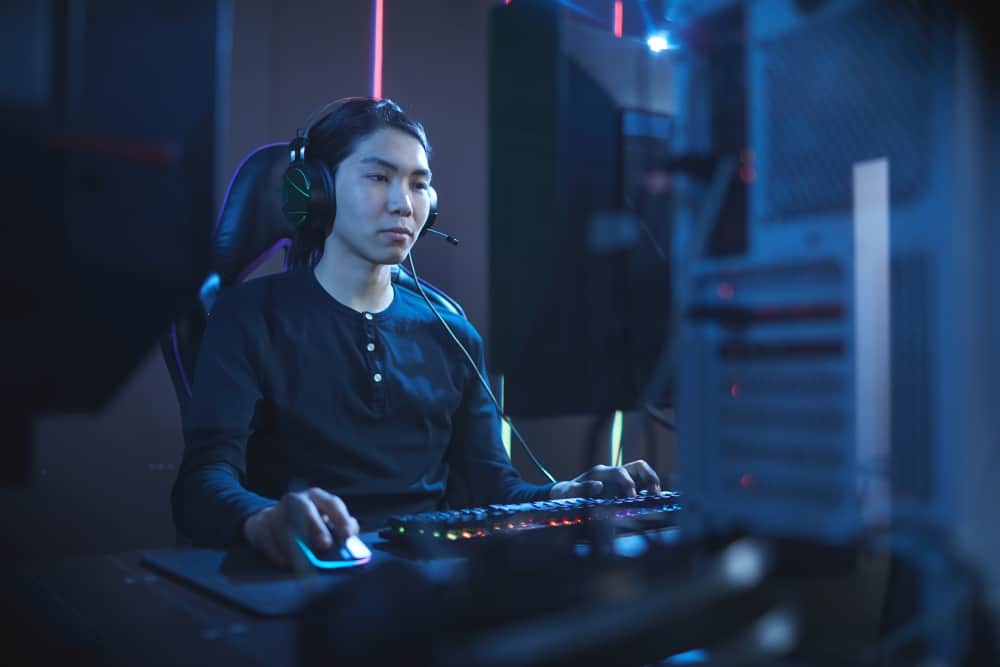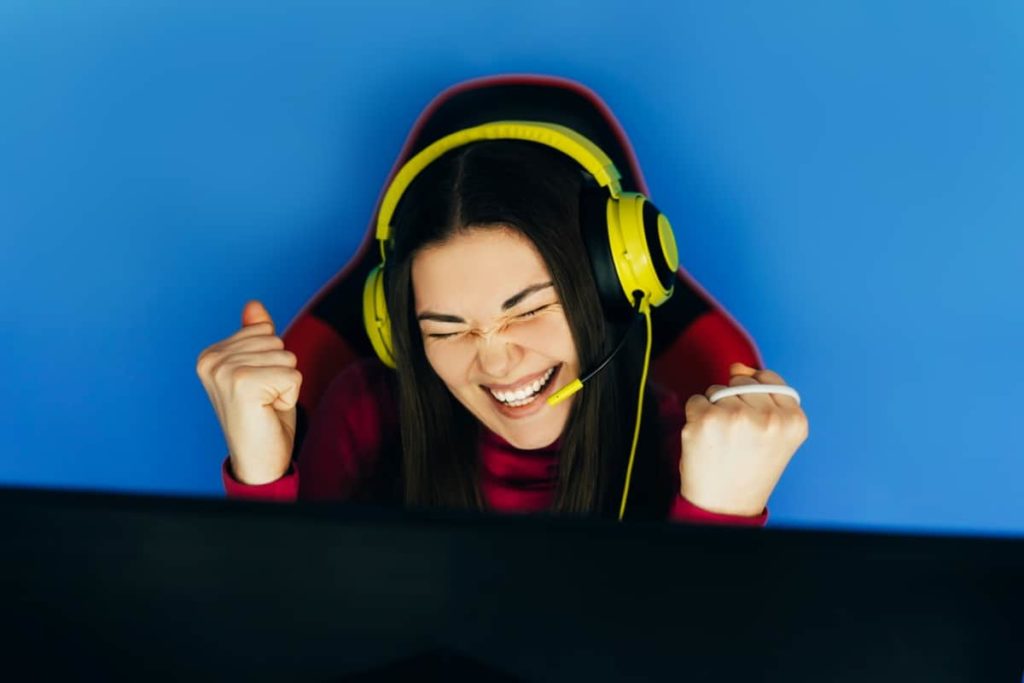But while lumbar pillows and neck support all play their part in making gaming chairs one of the most ergonomically sound seats out there, the benefits can go out the window if you’re not using your chair correctly.
Sitting down in a seat may not seem like rocket science, but as most gaming chairs don’t come with a set of instructions, many gamers wrongly assume that the chair is going to do all the work for them…
You can have the best ergonomic chair in the world at your disposal, but if you don’t sit properly in it, it’s going to have zero benefits.
While there is no such thing as the perfect sitting position, there is undoubtedly such a thing as a terrible sitting position and so we want to make sure that those with the good sense to purchase a gaming chair always get their money’s worth!
So without further ado, here’s how to use your gaming chair to its full potential and get that posture ready for some pro-gaming action.

How To Use A Gaming Chair Effectively
Step 1: Feet First
When thinking of yourself at your most comfortable, it’s unlikely you’d ever imagine a scenario without your feet up.
Putting your feet up is literally an instruction to relax in modern-day lexicon and so when trying to find the optimum position when at the office or home, the tootsies will often drift in a vertical fashion.
However, leaning back in your chair with your feet in the air is usually only relaxing and zen for half an hour or so, as the strain it puts on your lower back will eventually become quite a pain in the long run.

The key to straight posture comes from the feet and so by keeping them firmly on the floor, you can provide yourself with a powerful base to keep your spine straight within the chair.
This means regardless of any tilts, reclines or height adjustments you want to make, it’s imperative your feet are on the floor and in control.
If the comfiest seating position for you is at odds with this, you could even consider buying a footrest, allowing you to sit at a much greater height and keep your feet firmly planted.
Ideally, you want the height of the seat to align you in a way where your knees are positioned a few degrees lower than your hips, as this will provide the best angle for lumbar support.
If you’re a couch potato who’s been slouching your whole life, this might seem uncomfortable at first and so you might be tempted to go back to your old ways almost immediately.
This is because your spin is used to being in a tighter, curled shape and so your muscles and joints may feel like they are being stretched and straightened for the first few days (because they actually are!).
Stick with it until this gradually fades and you’ll find yourself on the road to a healthier posture in no time.
Step 2: It’s All In The Hips
For an act that seems second nature and relatively stress-free, we humans couldn’t be worse at sitting down, with most of us actively going about it the wrong way.
The reason so many of us feel lower back ache when we sit in high back chairs is because our hips are often too far forward, meaning when we lean back, our lumbar spine is completely unsupported and becomes strained.
This in turn then probably leads you to change position so that you are leaning forward and slouching over, which of course, affects posture.
Gaming chairs that utilise a huge lumbar support pillow can obviously help prevent this, but in order to maximise your lower back’s contact with the chair, it’s still recommended you tuck your hips into the seat as much as physically possible, as this will help the chair perfectly align up with your spine.
Step 3: Don’t Forget The Arm Rests
Getting your spine straight is all well and good, but an area of strain that people tend to forget about is the arms.
If the weight of your arms is not supported correctly in your gaming chair, you’ll quickly begin to feel aches and pains when holding them in the same position for too long and so to combat this, you’re going to need to get to grips with your armrests and their adjustment features.
It’s important to line up the armrests of your gaming chair with your desk space, as if they rest too high or too low, you’re going to be imbalanced and your seating position will be affected.

Most PC gaming chairs are incredibly similar in design and even the cheapest models will offer basic up and down adjustment, but the best chairs will offer you armrests with a ‘4D’ design.
This isn’t some kind of 3D experience with smello-vision though, as the D here stands for direction, not dimensions.
Standard gaming chairs will offer you between 1 and 4D, with those on the higher end of the scale being the most adaptable, as they offer more directions, giving you better options when it comes to supporting the arms and wrists.
Step 4: Neck & Lumbar Pillow Position
It’s imperative that when you sit back deep into your chair, that the support pillows slot in seamlessly with the natural curves of your body.
The lumbar pillow should be providing support for a natural curve in the lower back and the neck pillow should be positioned in the curve of the neck – not behind your head!
If these pillows aren’t in the correct position, you will see absolutely no benefits to your posture.
That being said, the neck pillow is often seen as optional, especially in the gaming scene, as most gamers choose to lean forward slightly to increase concentration, reaction and reflexes.
You must never neglect the lumbar pillow though, as this is paramount in helping to maintain or create a healthier posture.
Step 5: Nailing The Angle
Gaming chairs want you to be able to manoeuvre and adjust their seats to any position you like, with some even offering reclining features of up to 190-degrees!
While this is obviously great for a power nap, it’s not really a necessary feature for gaming chairs and instead just gives people the opportunity to accidentally over recline when trying to find that sweet spot.
Most experts recommend a recline of 100-110 degrees, as anything further back will leave you too relaxed and anything further forward will affect posture.
Try and alternate between these two angles throughout the day to activate different back muscles and keep others fresh, with a lower angle for gaming and work and a higher angle for passive computing.
Step 6: Don’t Be Afraid To Take Breaks!
Gamers and office workers could own the most revolutionary gaming chair in the world in an attempt to improve their wellbeing, but the fact remains that sitting for long periods of time just isn’t good for anyone!
That’s why even with gaming chairs it’s advised you take regular breaks every hour or so, as this will improve your mood and elevate your energy.
Pro gaming teams now incorporate periods of exercise to counteract the amount of time their athletes spend sitting, so make sure to get up and move every once in a while, even if it’s just to make yourself a drink!
Gaming Chair Errors To Avoid
If you follow the step by step guide above, you’ll probably learn something very quickly…
That maintaining a great posture can be incredibly hard and it’s incredibly easy to slip back into bad posture habits without even realising it!
So to help you avoid falling back down that slippery slope, we’ve put together a handy little checklist of gaming chair errors to watch out for.
Before You Buy: Picking The Right Size Chair
If you buy a gaming chair on the cheap without looking into its dimensions, you’re taking a huge gamble on whether you can even adjust the seat to be able to fit you!
If you choose a chair that’s too large, the support points won’t correctly align with your body and if too small, you’ll feel cramped and uncomfy.
It’s therefore crucial you always check the height of your chair, as well as the seat width and depth to ensure you won’t get lost or squashed in your new seat.
Be Strict With Yourself
Gaming chairs are naturally comfortable and so it’s easy to lose your posture at any time and assume the chair is still keeping you sweet.
However, those aches and pains will return if you’ve been sitting incorrectly, with the two most common mistakes either being leaning forwards too much or the hips slipping forwards and the lower back going unsupported.
To prevent this, your hips need to remain locked into the chair as deeply as possible and your back glued to the backrest.

Try and focus on your back being in contact with the backrest as much as possible, changing the reclining position if you ever feel you need to lean forward.
This is strangely one of the most difficult things to get used to with a gaming chair and requires a bit of getting used too, but ultimately, it’s the only way to improve that posture and combat wellbeing issues.
Crossing Legs & Feet Position
When you’re sitting for long periods of time, it’s only natural that your legs will get restless and begin moving all over the shop.
However, as previously stated, good posture begins and ends with firmly planted feet to give you a strong base and so crossing your legs or dangling feet is a big no-no.
If you catch yourself doing it, you’ll probably also notice your posture has completely crumbled too, so try and keep on top of this as best as you can or even practice if you find it difficult!
Workstation/Gaming Set-Up
All your good gaming chair work can be undone in seconds if your desk and monitor set-up aren’t up to scratch, so try and avoid these common pitfalls.
Firstly, you don’t want your monitor to be positioned too low or too high, as this will lead to craning the neck or hunching forward. This of course alters your posture and completely ruins the ergonomic benefits of your gaming chair.
To remedy this, try and ensure your PC monitor matches up with your eye line as this will prevent neck strain and head movement.
To do this, you can simply place some stable items like books or boxes under your monitor to raise it if too high, or raise your seat level if you’re too low, making sure to provide an adequate footrest if this causes you to lose your base.
Giving Up
Sitting in the correct posture can feel painful at first, especially if you’ve spent years slouching or leaning forward in your chair.
But it’s vital that if you buy a gaming chair, you don’t instantly give up on your posture the first time you come across any difficulty.
The added pillows and plush materials make it easy to slouch out in a gaming chair, but we promise you, the same problems of strain will return very quickly if you don’t remain strict on yourself.
Because why pay a fortune for a state of the art ergonomic chair if you’re not going to use it properly!?




